LORD OF THE RING
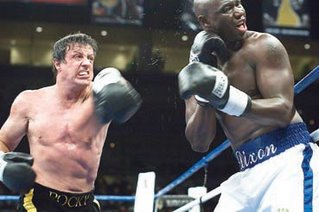
ROCKY BALBOA (12A)
reviewed by David Mahmoudieh at the
UK premier, Leicester Sq, London
Boxing movies have persistently proved themselves as prudent parables to life’s continual struggle. Now, 30 years since his original Oscar-winning Rocky back in 1976, master of the genre Sylvester Stallone dusts off the old robes and proves he still has every glint of a champion in that proverbial eye of the tiger as he brings back the most famous boxer that never was in Rocky Balboa, the last and arguably most developed instalment of the six-film saga.
A full 16 years after hanging up those golden gloves, and still appearing to talk through the combination of a permanent head-cold and a muzzle, the “Italian Stallion” now resembles more a tired, worn-out work-horse, leading a modest life back in Philly where he runs a small Italian restaurant – Adrian – named after his late, sorely-missed wife.
But even with his boxing days long departed, Rocky still hungers with a sense of unfinished business beyond the affectation that posing for mobile-phone photographs with his patrons offers him.
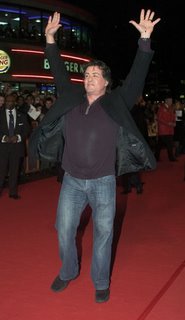
(Stallone greets fans who braved the
cold at the London premier)
So when sports-show ESPN broadcasts a computer-simulation of an in-his-prime Balboa battling the reigning heavyweight champ Mason Dixon (played by real-life boxer and former World champ Antonio Tarver), the result, a resounding victory for Balboa, more than intrigues the former people’s champion and inspires him to want to climb back in the ring.
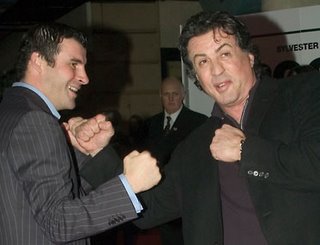
(Fact vs Fiction: real-life Champ and "Welsh/Italian Stallion"
Joe Calzaghe poses for a snap with Sly)
Faster than one of Rocky’s trademark left-hooks, promoters are arranging an exhibition match between the two warriors, welcomed by the publicly-loathed Dixon whose credibility is flailing fast in the absence of any real competition.
It isn’t long before the ripened-old Rocky (screen-age 50, compared to Stallone’s real age of 60) is rounding up all the familiar touchstones of brother-in-law Paulie (Burt Young) and corner man Duke (Tony Burton) for that “one last fight” – but not a second before one final gruelling training montage complete with Bill Conti’s “Gonna Fly Now” bursting through the speakers.
And by the end of it, even if his neck does resemble the tail-ends of a rubber mask, Sly’s body is in incredible shape for a man who technically qualifies for a free bus-pass.
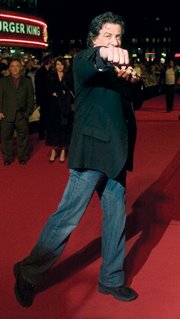
(Stallone's chin appears to have grown a
fist as he lets his knuckles do the talkin')
What impresses me most, though, about writer/director/star Stallone is how this one evidently means so much more than just some frigid attempt to fathom a quick buck or two from a long-gone but clearly not forgotten franchise, and is in fact more a painfully-sung romantic serenade, in a kind of kiss-of-death incongruity, as Stallone delivers the knockout blow to the title character he created on both paper and screen that provided the career momentum to shoot to present-day fame and prominence.
A fitting end to a genuine screen hero.
© David Mahmoudieh 2007

ROCKY BALBOA (12A)
reviewed by David Mahmoudieh at the
UK premier, Leicester Sq, London
Boxing movies have persistently proved themselves as prudent parables to life’s continual struggle. Now, 30 years since his original Oscar-winning Rocky back in 1976, master of the genre Sylvester Stallone dusts off the old robes and proves he still has every glint of a champion in that proverbial eye of the tiger as he brings back the most famous boxer that never was in Rocky Balboa, the last and arguably most developed instalment of the six-film saga.
A full 16 years after hanging up those golden gloves, and still appearing to talk through the combination of a permanent head-cold and a muzzle, the “Italian Stallion” now resembles more a tired, worn-out work-horse, leading a modest life back in Philly where he runs a small Italian restaurant – Adrian – named after his late, sorely-missed wife.
But even with his boxing days long departed, Rocky still hungers with a sense of unfinished business beyond the affectation that posing for mobile-phone photographs with his patrons offers him.

(Stallone greets fans who braved the
cold at the London premier)
So when sports-show ESPN broadcasts a computer-simulation of an in-his-prime Balboa battling the reigning heavyweight champ Mason Dixon (played by real-life boxer and former World champ Antonio Tarver), the result, a resounding victory for Balboa, more than intrigues the former people’s champion and inspires him to want to climb back in the ring.

(Fact vs Fiction: real-life Champ and "Welsh/Italian Stallion"
Joe Calzaghe poses for a snap with Sly)
Faster than one of Rocky’s trademark left-hooks, promoters are arranging an exhibition match between the two warriors, welcomed by the publicly-loathed Dixon whose credibility is flailing fast in the absence of any real competition.
It isn’t long before the ripened-old Rocky (screen-age 50, compared to Stallone’s real age of 60) is rounding up all the familiar touchstones of brother-in-law Paulie (Burt Young) and corner man Duke (Tony Burton) for that “one last fight” – but not a second before one final gruelling training montage complete with Bill Conti’s “Gonna Fly Now” bursting through the speakers.
And by the end of it, even if his neck does resemble the tail-ends of a rubber mask, Sly’s body is in incredible shape for a man who technically qualifies for a free bus-pass.

(Stallone's chin appears to have grown a
fist as he lets his knuckles do the talkin')
What impresses me most, though, about writer/director/star Stallone is how this one evidently means so much more than just some frigid attempt to fathom a quick buck or two from a long-gone but clearly not forgotten franchise, and is in fact more a painfully-sung romantic serenade, in a kind of kiss-of-death incongruity, as Stallone delivers the knockout blow to the title character he created on both paper and screen that provided the career momentum to shoot to present-day fame and prominence.
A fitting end to a genuine screen hero.
© David Mahmoudieh 2007
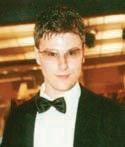

0 Comments:
Post a Comment
<< Home